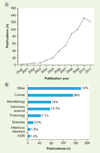Advances in the proteomic investigation of the cell secretome
- PMID: 22809211
- PMCID: PMC3500636
- DOI: 10.1586/epr.12.21
Advances in the proteomic investigation of the cell secretome
Abstract
Studies of the cell secretome have greatly increased in recent years owing to improvements in proteomic platforms, mass spectrometry instrumentation and to the increased interaction between analytical chemists, biologists and clinicians. Several secretome studies have been implemented in different areas of research, leading to the generation of a valuable secretome catalogs. Secreted proteins continue to be an important source of biomarkers and therapeutic target discovery and are equally valuable in the field of microbiology. Several discoveries have been achieved in vitro using cell culture systems, ex vivo using human tissue specimens and in vivo using animal models. In this review, some of the most recent advances in secretome studies and the fields that have benefited the most from this evolving technology are highlighted.
Conflict of interest statement
The authors have no other relevant affiliations or financial involvement with any organization or entity with a financial interest in or financial conflict with the subject matter or materials discussed in the manuscript apart from those disclosed.
No writing assistance was utilized in the production of this manuscript.
Figures



References
-
-
An E, Sen S, Park SK, Gordish-Dressman H, Hathout Y. Identification of novel substrates for the serine protease HTRA1 in the human RPE secretome. Invest. Ophthalmol. Vis. Sci. 2010;51(7):3379–3386. •• Discusses the comprehensive secretome of human retinal pigment epithelial cells.
-
-
-
Formolo CA, Williams R, Gordish-Dressman H, MacDonald TJ, Lee NH, Hathout Y. Secretome signature of invasive glioblastoma multiforme. J. Proteome Res. 2011;10(7):3149–3159. •• Discusses the comprehensive secretome of glioblastoma ‘most invasive brain tumor cells’.
-
-
-
Korpal M, Ell BJ, Buffa FM, et al. Direct targeting of Sec23a by miR-200s influences cancer cell secretome and promotes metastatic colonization. Nat. Med. 2011;17(9):1101–1108. •• Discusses the role miRNA plays in tumor metastasis via secreted proteins.
-
-
- Pavlou MP, Diamandis EP. The cancer cell secretome: a good source for discovering biomarkers? J. Proteomics. 2010;73(10):1896–1906. - PubMed
-
-
Wu CC, Hsu CW, Chen CD, et al. Candidate serological biomarkers for cancer identified from the secretomes of 23 cancer cell lines and the human protein atlas. Mol. Cell Proteomics. 2010;9(6):1100–1117. •• Discusses the comprehensive secretome profile of 23 cancer cell lines.
-
Websites
-
- Proteomics Identifications database (PRIDE) www.ebi.ac.uk/pride.
-
- The ProteomeXchange Consortium. www.proteomexchange.org.
-
- Cancer Biomedical Informatics Grid. https://cabig.nci.nih.gov.
-
- UniProt. www.uniprot.org.
-
- SignalP 4.0 Server. www.cbs.dtu.dk/services/SignalP.
Publication types
MeSH terms
Substances
Grants and funding
LinkOut - more resources
Full Text Sources
Other Literature Sources
